Peacock cichlids are a popular choice for aquarium enthusiasts. These colorful fish are known for their vibrant hues and unique patterns, making them a stunning addition to any tank. However, caring for these fish requires a bit of knowledge and attention to detail.
Peacock cichlids require a well-maintained aquarium with suitable water conditions, a varied diet, and a peaceful environment. They need a pH range of 7.8-8.6 and a temperature range between 76-82°F. The aquarium should be decorated with rocks and caves, and regular water changes should be performed to ensure their health. They are peaceful and social fish, making them an excellent choice for community tanks.
In this article, you’ll find everything you need to know about peacock cichlid care. From setting up the perfect tank to maintaining water quality, we’ll cover all the essentials. Whether you’re a seasoned fish owner or a beginner, you’ll find valuable information to help you keep your peacock cichlids healthy and happy.
As someone who has owned peacock cichlids for years, I can attest to the joy they bring to any aquarium. However, I’ve also learned firsthand the importance of proper care and attention. With the right knowledge and commitment, you can create a thriving environment for your peacock cichlids and enjoy their beauty for years to come.
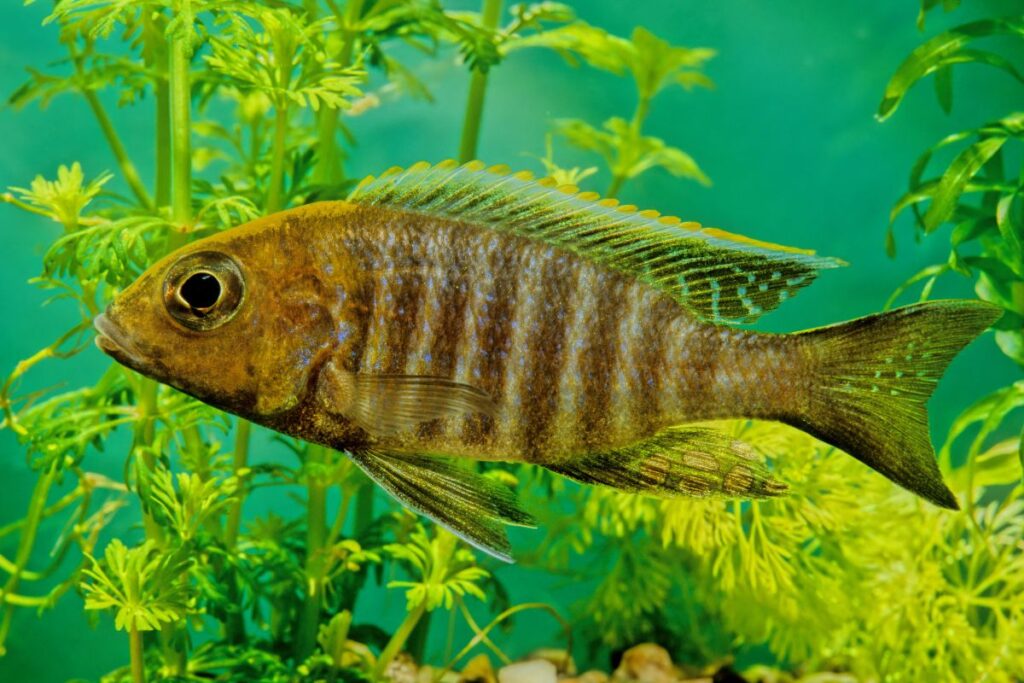
Table of Contents
Species Summary
Origin
Peacock cichlids are native to Lake Malawi in Africa.
They were first discovered in the 1950s and have since become a popular species in the aquarium hobby.
Lifespan
Peacock cichlids have a lifespan of 8 to 10 years in captivity with proper care.
Appearance
Peacock cichlids are known for their vibrant colors and unique patterns.
They have a sleek, oval-shaped body and can grow up to 6 inches in length.
Their fins are long and flowing, adding to their overall beauty.
Size
Peacock cichlids can grow up to 6 inches in length, with males typically being larger than females.
Growth rate
Peacock cichlids have a moderate growth rate and can take up to a year to reach their full size.
Behavior & Temperament
Peacock cichlids are generally peaceful and can be kept in community tanks with other non-aggressive fish.
However, males can become territorial during breeding season and may become aggressive towards other males.
Male vs Female
Males are typically larger and more colorful than females. Males also have longer fins and may develop a hump on their forehead during breeding season.
Overall, peacock cichlids are a beautiful and fascinating species that can make a great addition to any aquarium.
With proper care and attention, they can live long and healthy lives in captivity. As an aquarium enthusiast, I have personally found peacock cichlids to be a joy to watch and care for.
Tank Setup
Tank Size
When it comes to peacock cichlid care, one of the most important factors to consider is the size of the tank.
Peacock cichlids need plenty of space to swim around and establish their territory, so it’s recommended to have a tank that is at least 55 gallons or larger.
Lighting
Peacock cichlids prefer dimly lit environments, so it’s best to avoid bright lighting in their tank.
A low-wattage bulb or LED light that emits a soft, warm glow is ideal for these fish.
Filtration
Good filtration is crucial for maintaining a healthy environment for your peacock cichlids.
A high-quality filter that can handle the size of your tank is recommended.
Canister filters are a popular choice among fish keepers because they provide excellent mechanical, chemical, and biological filtration.
Aeration
Aeration is important for maintaining oxygen levels in the tank.
A good air pump and air stone can help circulate the water and keep it oxygenated.
Heater
Peacock cichlids are tropical fish and require a consistent water temperature of around 78-82°F.
A reliable heater that can maintain a consistent temperature is essential for their health and well-being.
Substrate
Peacock cichlids prefer a sandy substrate that mimics their natural environment.
A depth of at least 2-3 inches is recommended to allow for burrowing and foraging.
Decorations
Peacock cichlids enjoy having plenty of hiding spots and areas to explore.
Adding rocks, caves, and driftwood to the tank can provide these fish with the stimulation they need to thrive.
Plants
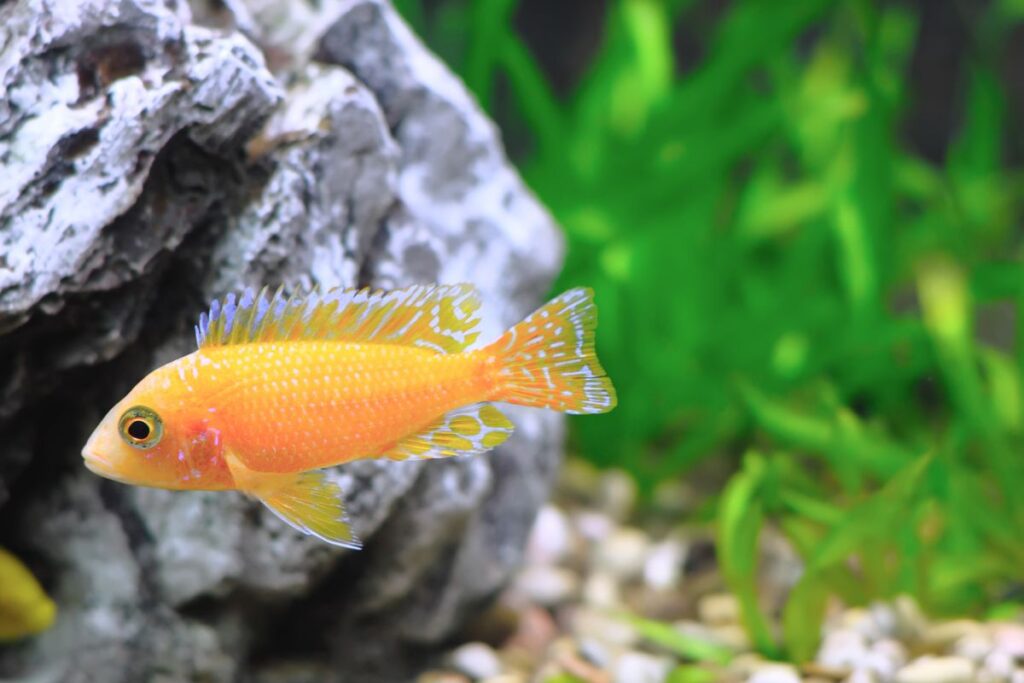
While peacock cichlids are not known for eating plants, they may uproot them while digging in the substrate.
Hardy plants like Java fern and Anubias can be attached to rocks or driftwood to provide a natural look to the tank without the risk of being uprooted.
Water Parameters
Temperature
The ideal temperature range for peacock cichlids is between 76-82°F (24-28°C). It is important to maintain a consistent temperature within this range to ensure the health and well-being of your fish.
Fluctuations in temperature can cause stress and weaken the immune system of your fish, making them more susceptible to diseases.
pH
Peacock cichlids prefer a slightly alkaline pH level between 7.8-8.6. It is important to monitor the pH level regularly, as fluctuations can cause stress and even death.
Use a pH test kit to ensure that the water remains within the desired range.
Hardness
Peacock cichlids prefer moderately hard water with a hardness level between 10-20 dGH.
This can be achieved by adding aquarium salt or using a water conditioner specifically designed for cichlids.
Water Changes
Regular water changes are crucial for maintaining good water quality and the health of your fish. It is recommended to change 10-20% of the water every week.
This helps remove excess nutrients and waste products that can accumulate in the tank over time.
When performing water changes, it is important to use a dechlorinator to remove any harmful chemicals that may be present in tap water.
Also, make sure to match the temperature and pH level of the new water to that of the tank to avoid any sudden changes that can stress your fish.
As an anecdote, I once had a peacock cichlid that became lethargic and stopped eating. After testing the water parameters, I discovered that the pH level had dropped significantly.
I immediately performed a water change and adjusted the pH level, and within a few days, my fish had fully recovered.
This experience taught me the importance of regularly monitoring and maintaining the water parameters for my fish.
Feeding
Diet
Peacock cichlids are omnivores, which means they eat both plant and animal matter. In the wild, their diet consists of insects, crustaceans, and small fish.
In captivity, it’s important to provide them with a varied diet to ensure they get all the nutrients they need.
Pellets and flakes are a good staple food, but supplementing with live or frozen foods like brine shrimp, bloodworms, and krill will keep your peacock cichlids healthy and happy.
Feeding Schedule
Peacock cichlids should be fed twice a day, with only as much food as they can consume in a few minutes.
Overfeeding can lead to health problems like bloating and swim bladder issues. It’s also important to keep track of your fish’s weight and adjust their feeding schedule accordingly.
If they start to gain weight, cut back on their food intake.
Feeding Tips
When feeding your peacock cichlids, it’s important to remember that they are messy eaters. Uneaten food can quickly pollute the water and lead to health problems.
To avoid this, remove any uneaten food after a few minutes. You can also try using a feeding ring to keep the food in one place and make cleanup easier.
Another tip is to vary the type of food you feed your peacock cichlids. This not only provides them with a more balanced diet, but it also keeps them interested and engaged in their food.
Personally, I have found that my peacock cichlids love live food like brine shrimp and bloodworms. It’s a great way to give them a treat and watch them hunt and eat.
Just be sure to only feed live food occasionally and in moderation. Overall, proper feeding is essential to the health and well-being of your peacock cichlids.
By providing them with a varied diet, sticking to a feeding schedule, and cleaning up any uneaten food, you can ensure that your fish live a long and healthy life.
Behavior
Compatibility
Peacock cichlids are generally peaceful and can be kept with other non-aggressive fish. However, it is important to note that they may become territorial during breeding season.
It is best to avoid keeping them with aggressive or larger fish, as they may become intimidated and stressed.
Aggression
Peacock cichlids are not typically aggressive, but they may become territorial during breeding season.
It is important to provide them with plenty of hiding places and enough space to establish their own territories.
If they do become aggressive, it may be necessary to separate them from other fish in the tank.
How Many Peacock Cichlids Can Be Kept Together
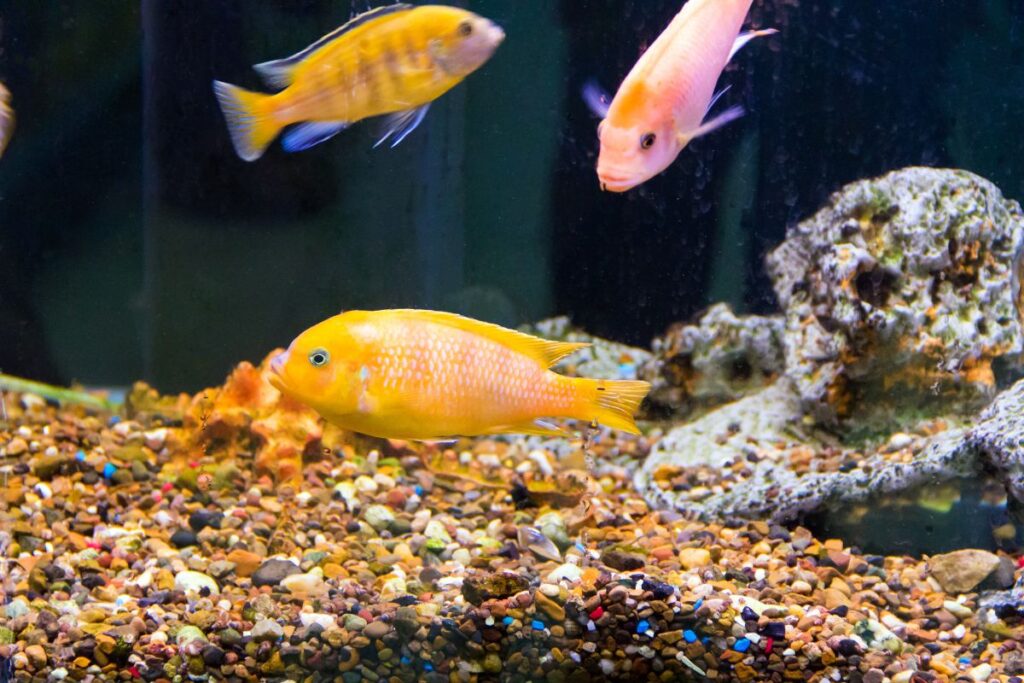
Peacock cichlids can be kept in groups of six or more, as long as they have enough space to establish their own territories.
It is important to provide them with plenty of hiding places and decorations to break up the line of sight in the tank.
This will help to reduce aggression and stress among the fish. I remember the first time I introduced a new peacock cichlid to my tank.
I was worried about how my existing fish would react, but I made sure to provide plenty of hiding places and decorations to break up the line of sight in the tank.
To my surprise, the new fish was welcomed with open fins and quickly established its own territory. It was a great reminder of how important it is to create a comfortable environment for these beautiful fish.
Health
Common Diseases
Peacock cichlids are generally healthy fish, but they can still be prone to certain diseases. One of the most common diseases that affects peacock cichlids is ich.
Ich is a parasite that causes white spots to appear on the fish’s body. Another common disease is fin rot, which causes the fins to deteriorate and fall off.
Prevention
The best way to prevent diseases in your peacock cichlids is to maintain a clean and healthy environment for them. This means regularly cleaning the tank and ensuring that the water quality is good.
You should also avoid overcrowding the tank and make sure that your fish have enough space to swim around.
Treatment
If you notice that your peacock cichlid is sick, it’s important to act quickly. The first step is to isolate the sick fish from the others to prevent the disease from spreading.
You can then treat the fish with medications that are designed to target the specific disease. It’s important to follow the instructions on the medication carefully and to continue treatment until the fish has fully recovered.
I once had a peacock cichlid that developed ich. It was a stressful experience, but I was able to treat the fish with medication and it made a full recovery.
Since then, I’ve been diligent about maintaining a clean and healthy environment for my fish to prevent any future illnesses.
Signs of a Healthy Peacock Cichlid
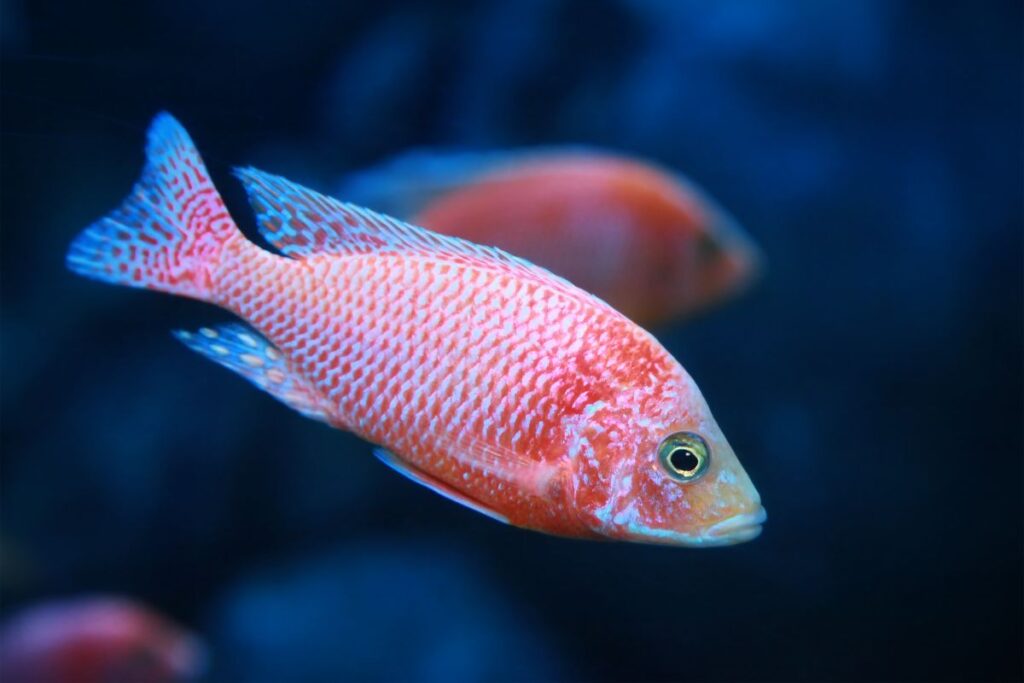
Peacock cichlids are known for their vibrant colors and active personalities. As a responsible owner, it’s important to be able to recognize the signs of a healthy peacock cichlid. Here are a few key indicators to look out for:
- Bright and Vibrant Colors: One of the most obvious signs of a healthy peacock cichlid is its bright and vibrant colors. A healthy cichlid will have deep, rich colors that are consistent throughout its body.
- Active and Energetic Behavior: Another sign of a healthy peacock cichlid is its active and energetic behavior. A healthy cichlid will be constantly swimming around its tank, exploring its surroundings, and interacting with other fish.
- Clear Eyes and Scales: A healthy peacock cichlid will have clear eyes and scales. Cloudy or discolored eyes, as well as scales that appear dull or damaged, can be indicators of illness or disease.
- Healthy Appetite: A healthy peacock cichlid will have a healthy appetite and will eagerly eat its food. If your cichlid is not eating or appears to be losing weight, it may be a sign of an underlying health issue.
It’s important to keep a close eye on your peacock cichlid’s behavior and appearance to ensure that it remains healthy and happy. By recognizing the signs of a healthy cichlid, you can take the necessary steps to provide it with the best possible care.
Personally, I have found that my peacock cichlids are at their healthiest when they are provided with a varied diet that includes both high-quality pellets and live or frozen foods.
I also make sure to keep their tank clean and well-maintained, with regular water changes and proper filtration. By following these simple steps, I have been able to keep my peacock cichlids healthy and thriving for years.
Signs of a Sick Peacock Cichlid
If you’re a peacock cichlid owner, it’s essential to know the signs of a sick fish. Catching an illness early can help you treat it before it becomes fatal. Here are some of the most common signs that your peacock cichlid may be sick:
- Loss of appetite
- Unusual swimming behavior
- Discoloration or spots on the body
- Clamped fins
- Scratching against objects in the tank
If you notice any of these signs, it’s important to act quickly. The first step is to check the water parameters to ensure they’re within the appropriate range for peacock cichlids.
Poor water quality can cause stress and weaken the immune system, making fish more susceptible to illnesses.
If the water parameters are fine, the next step is to isolate the sick fish in a separate tank to prevent the spread of the illness to other fish in the community tank.
You can then treat the fish with medication or seek the advice of a veterinarian.
It’s important to note that prevention is always better than cure.
Regular water changes, a balanced diet, and a stress-free environment can go a long way in keeping your peacock cichlids healthy and happy.
Personal Anecdote: I once had a peacock cichlid that stopped eating and became lethargic. I quickly isolated him and treated him with medication, and he made a full recovery.
It’s important to pay close attention to your fish and take action at the first sign of illness.
Breeding
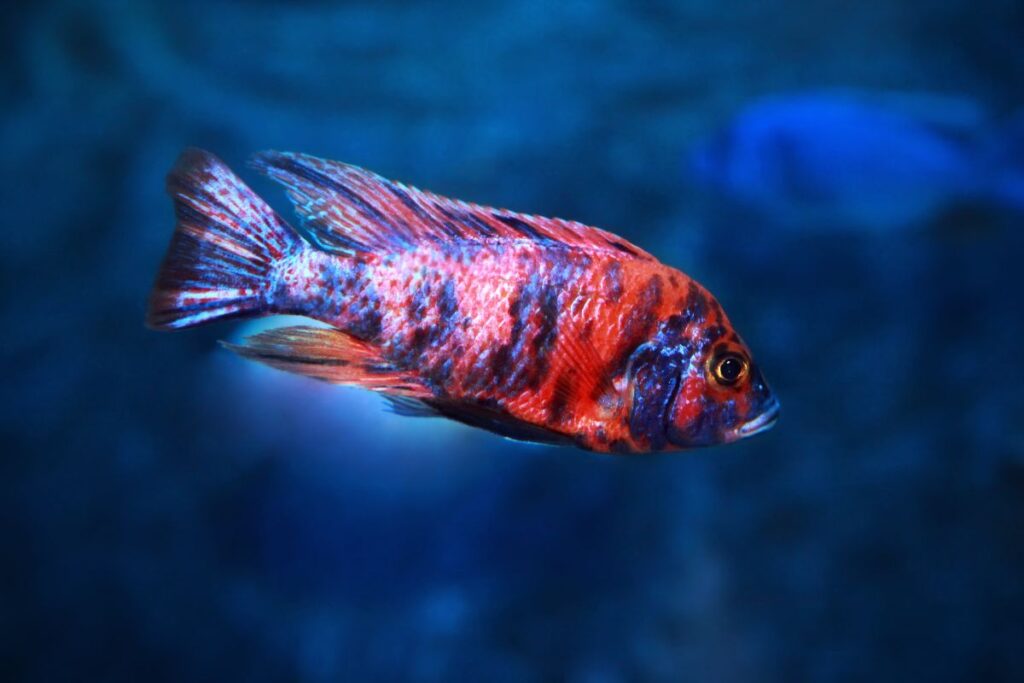
Setup
Before attempting to breed Peacock Cichlids, it is important to create the right environment for them.
A large tank with plenty of hiding places and a flat surface for spawning is necessary.
The water should be kept at a temperature between 78-82°F and the pH level should be around 7.8-8.6.
A good filtration system is also important to keep the water clean and healthy for the fish.
How to Tell if a Peacock Cichlid is Male or Female
It can be difficult to tell the difference between male and female Peacock Cichlids.
However, there are a few key physical characteristics to look out for.
Males tend to have more vibrant colors and longer fins, while females have shorter fins and less vibrant colors.
Another way to tell is by looking at the genital papilla, which is a small protrusion located near the vent.
Males have a pointed and elongated papilla, while females have a shorter and rounder papilla.
Care
Once you have identified a male and female pair, it is important to provide them with the right care to encourage breeding.
Feed them a varied diet of high-quality pellets, frozen or live foods to ensure that they are healthy and in good condition.
It is also important to keep the water quality high with regular water changes and maintenance.
During the breeding process, the male will typically create a spawning site by cleaning a flat surface and defending it from other fish.
The female will lay her eggs on this surface, and the male will fertilize them. After spawning, it is important to remove any other fish from the tank to prevent them from eating the eggs or fry.
The eggs will hatch in about three days, and the fry will be free-swimming after another three to four days.
At this point, they can be fed with small amounts of crushed flakes or baby brine shrimp.
Overall, breeding Peacock Cichlids can be a rewarding experience for fish keepers.
With the right setup, care, and attention, these fish can thrive and produce healthy offspring.
Personally, I have found that the breeding process can be quite fascinating to watch. It is amazing to see the male create a spawning site and the female lay her eggs. It is also rewarding to see the fry grow and develop into healthy young fish. However, it is important to remember that breeding fish requires patience, dedication, and a willingness to learn.
Recommended Products:
- Aqueon Aquarium Fish Tank – This 55-gallon tank is perfect for peacock cichlids as it provides ample space for swimming and establishing territories.
- Marineland LED Aquarium Light – This low-wattage LED light provides a soft, warm glow that is ideal for peacock cichlids who prefer dimly lit environments.
- Fluval Canister Filter – This high-quality canister filter provides excellent mechanical, chemical, and biological filtration, making it ideal for maintaining a healthy environment for your peacock cichlids.
- Tetra Whisper Air Pump – This air pump helps to circulate the water and keep it oxygenated, which is important for maintaining good water quality and the health of your fish.
- Eheim Jager Aquarium Thermostat Heater – This reliable heater can maintain a consistent temperature, which is essential for the health and well-being of your peacock cichlids.
- CaribSea Super Naturals Aquarium Sand – This sandy substrate mimics the natural environment of peacock cichlids and provides a great depth of 2-3 inches for burrowing and foraging.
- Penn-Plax Stone Hideaway – This rock decoration provides a hiding spot for your peacock cichlids and adds to the natural look of the tank.
- Java Fern – This hardy plant can be attached to rocks or driftwood to provide a natural look to the tank without the risk of being uprooted by your peacock cichlids.
- API Aquarium Test Kit – This pH test kit can help you monitor the pH level of your tank regularly, which is important for maintaining good water quality and the health of your fish.
- Omega One Cichlid Pellets – This high-quality pellet food provides a balanced diet for your peacock cichlids and is a good staple food to supplement with live or frozen foods like brine shrimp, bloodworms, and krill.
Conclusion
Overall, peacock cichlids are a beautiful and fascinating addition to any aquarium. They require a bit more care and attention than some other fish, but the effort is well worth it for their stunning colors and unique personalities.
When caring for peacock cichlids, it is important to maintain a stable environment with proper water conditions and a balanced diet. Regular water changes and monitoring for signs of illness or aggression can help keep your fish healthy and happy.
Remember to provide plenty of hiding places and decorations to create a comfortable and stimulating environment for your peacock cichlids. And don’t forget to research any potential tank mates to ensure compatibility.
As an avid aquarium hobbyist, I can personally attest to the joy and satisfaction that comes from successfully caring for and breeding peacock cichlids. With patience and dedication, anyone can enjoy the beauty and wonder of these amazing fish.
FAQs
Here are some frequently asked questions about peacock cichlid care:
Q: What should I feed my peacock cichlids?
A: Peacock cichlids are omnivores, so they will eat a variety of foods. You can feed them a high-quality pellet or flake food as a staple, and supplement their diet with live or frozen foods like brine shrimp, bloodworms, or krill. It’s important not to overfeed them, as this can lead to health problems.
Q: How often should I do water changes?
A: It’s recommended to do a 25% water change every week to keep the water quality high. If you have a heavily stocked tank, you may need to do more frequent water changes.
Q: Can peacock cichlids live with other fish?
A: Peacock cichlids can live with other non-aggressive species of fish that are similar in size. It’s important to research the compatibility of any fish you want to add to your tank before doing so.
Q: How can I tell if my peacock cichlids are male or female?
A: Male peacock cichlids are usually more colorful than females, with brighter and more vibrant colors. They also have longer fins and a more elongated body shape. Females tend to be smaller and less colorful.
Q: Do peacock cichlids need a lot of space?
A: Peacock cichlids should be kept in a tank that is at least 55 gallons, with plenty of hiding places and swimming space. It’s important to provide them with a comfortable and stress-free environment to thrive in.
Personally, I’ve found that peacock cichlids are fascinating fish to watch and care for. By following these care guidelines, you can ensure that your peacock cichlids live a healthy and happy life in your aquarium.
Reference: Wikipedia.
